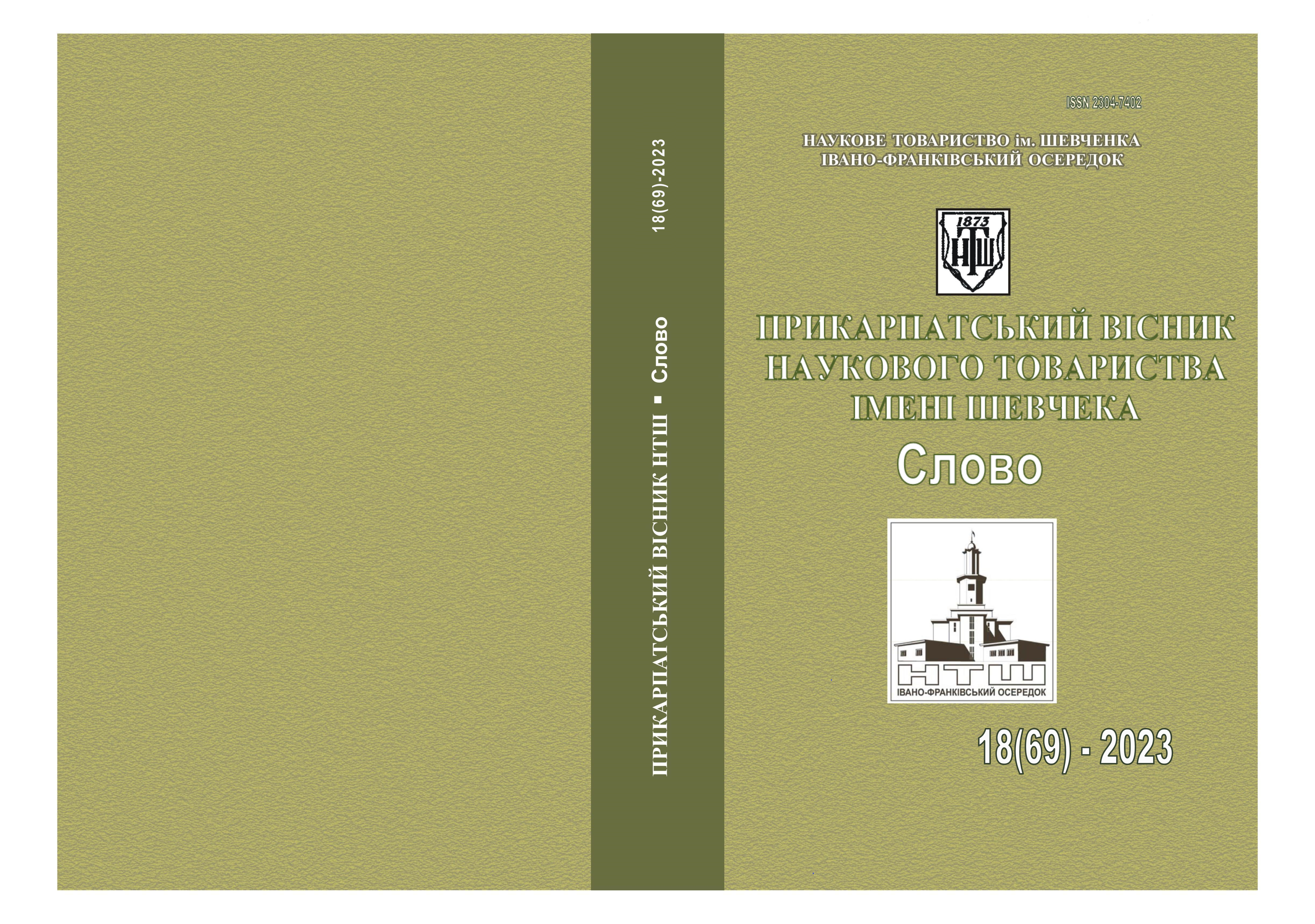FOLKLORE AND MYTHOLOGICAL IMAGES OF THE HOMEWORK AND THE FORESTMAN IN THE ARTISTIC PLANE OF CHILDREN’S STORIES BY V. VYNNYCHENKA
DOI:
https://doi.org/10.31471/2304-7402-2023-18(69)-349-362Keywords:
folklore, children's stories, mythology, domovyk, transformation.Abstract
The article analyses Volodymyr Vynnychenko's children's stories from the point of view of reproducing elements of the national code of Ukrainians recorded in folklore texts. Attention is focused on the author's works "The Winds Are Blowing, the Winds Are Raging" and "Hey, who’s in the Woods, Call Out". It is established that the latter actively use folklore motifs, genres and images. They allow us to explain some of the folk traditions of our ancestors, to show the inseparability of the connection between the past and the present, and to recreate the flavour of the described era. It is determined that Ukrainian culture is characterised by beliefs in the existence of supernatural beings - witches, demons, devils, mermaids, sorcerers, werewolves - who can help or harm people. Vynnychenko borrows the images of a housekeeper and a forest man from folklore. The purpose of the study is to trace their transformation in these works and to find out their psycho-emotional impact on the characters. The historical and literary, comparative genetic, comparative typological and intertextual methods were used.
Novelty. For the first time, the author analyses folklore and mythological characters in Vynnychenko's children's stories. It is proved that his forest man/Korchun underwent a significant literary transformation in the text. Parallels with typologically related images in world culture are drawn. The functions of folklore elements in the works are clarified: the composition of the stories is built around them, the characteristics of the main characters are revealed through the attitude to folklore images, and the author's ideological and aesthetic concepts are realised. And in stressful situations associated with their appearance, the consciousness of small personalities is formed.
The practical significance of the study lies in the fact that its results can be used in further research on literary and folklore correlations in V. Vynnychenko's works.
References
Варданян М. Україна на роздоріжжі: еміграційний цикл оповідань «Намисто» В. Винниченка в контексті радянської дитячої літератури 20-х років ХХ століття. Науковий збірник Миколаївського національного університету імені В. О. Сухомлинського, 2017, № 2 (20), 47–51.
Винниченко В. Намисто: оповідання. Київ: Веселка, 1989, 401 с.
Виноградова Л. Народна демонологія та міфо-обрядова традиція слов'ян. Харків: Індрик, 2000, 276 с.
Вовк О. Емоційний потенціал дитячих оповідань Володимира Винниченка. Літературознавчі студії. Актуальні питання гуманітарних наук, 2015, № 2, 193–198.
Кузьменко О. Драматизм людського буття в українському фольклорі: концептуальні форми вираження (період Першої та Другої світових воєн). Львів: Інститут народознавства, 2018, 345 с.
Коцюбинська М. Етюди про поетику Шевченка: Літературно-критичний нарис. Київ, 1990, 272 с.
Літературознавчий словник-довідник / за ред. Р. Т. Гром’яка, Ю. І. Коваліва, В. І. Теремка. Київ : Академія, 2006. 752 с
Марків Р. Теоретичні аспекти фольклоризму в літературі. Вісник Львівського університету. Серія філологічна, 2010, № 41, 215–223.
Михида С. Модерна Україна: особистість – мегатекст – поетика. Кіровоград: Поліграф-Сервіс, 2013, 347 с.
Потапенко С. Проблема тексту у фольклорі з погляду теорії інтертекстуальності. Літературознавчі студії, 2010, № 26, 455–459.
Скиба Р. Фольклорні моделі у літературному тексті (темрява і її противага в «Страшній помсті М. Гоголя»). Молода нація, 1997, № 5, 101–104.
Снігирьова М. Фольклор у формуванні національної ідентичності. Science and Education a New Dimension. Філологія, 2018, № VI (43), 53–55.
Тиховськ О. Персоніфікація архетипу Тіні в міфологічному світогляді українців. Сучасні проблеми мовознавства та літературознавства: збірник наукових праць. Ужгород, 2015, № 20, 130–135.
Чепурко О. Образи дітей в українській малій прозі кінця 19 – початку 20 століття. Вісник Житомирського державного університету імені І. Франка, 2004, № 15, 215–218.
Янковська Ж. Українська народницька романтична проза. Львів: Українські технології, 2016, 278 с.
Al-Haidari, A., & Bhanegaonkar S. (2012). Reflections of Ancient Mythical Characters in European Literature: A Review of Antiquity and Contemporaneity. International Journal of Social Science Tomorrow, 1 (4), 1–7.
Attebery, Brian (2014) Stories about Stories: Fantasy and the Remaking of Myth. New York: Oxford University Press.
Baumbach, S. (2009). The Knowledge of Myth in Literature: The Fascination of Mythopoetic Space and William Drummond’s ‘The Statue of Medusa'. In A. Locatelli, The Knowledge of Literature (pp.121–140). Bergamo University Press.
Dundes, A. (2005). Folkloristics in the Twenty-First Century. Journal of American Folklore, 118, 385-408.
Gaystor, А. (2015). Slavic mythology. Kyiv: Clio.
Otero, S., Martínez-Rivera, М. (Eds). (2021). Theorizing Folklore from the Margins: Critical and Ethical Approaches (Activist Encounters in Folklore and Ethnomusicology). Indiana University Press.

